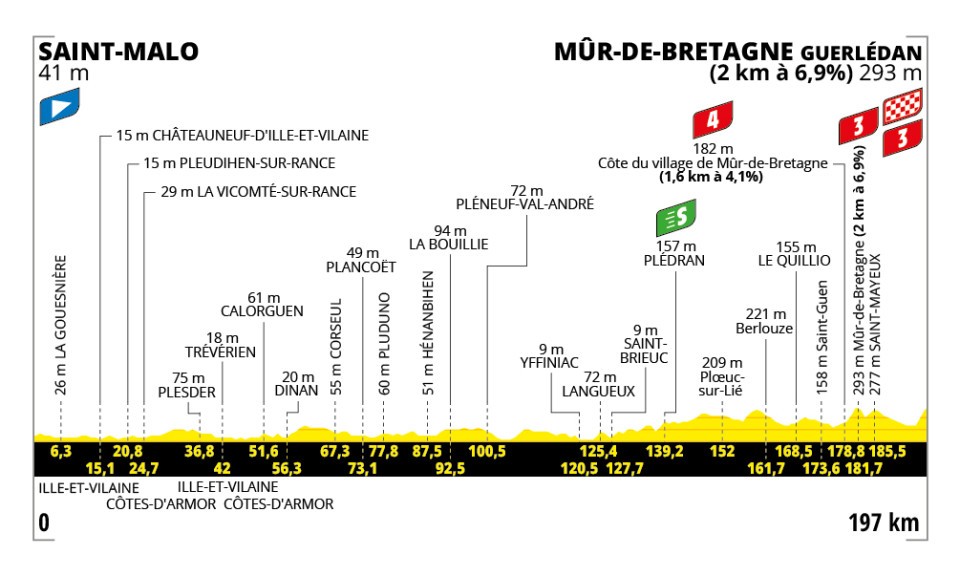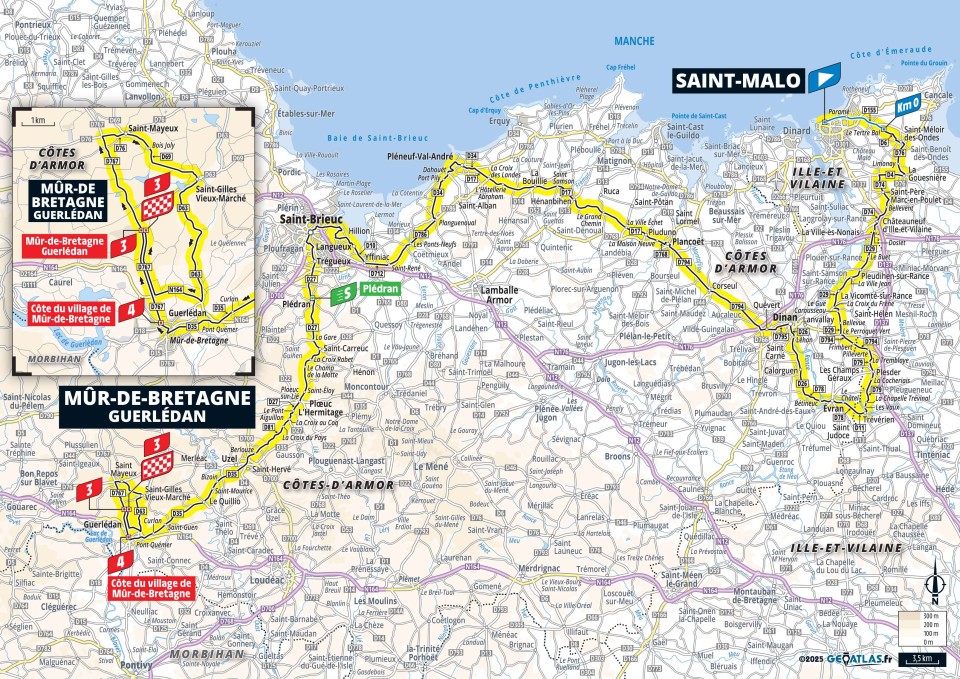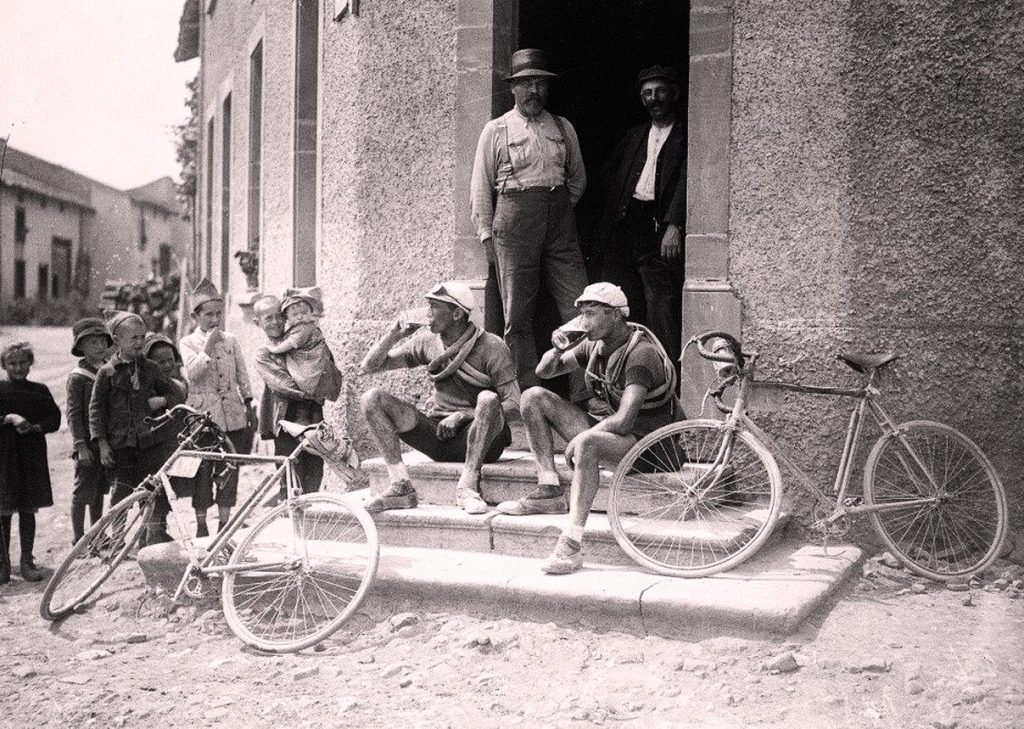Tour de France 2025 visits Bretagne.


Tour de France 2025 stage 7
PREVIOUSLY AT THE TOUR DE FRANCE 2025
The opening six stages of the 2025 Tour de France have provided a varied and eventful start to the race. Covering terrain across northern France and Normandy, the first week has included flat sprint stages, hilly classics-style finishes, and a key individual time trial—offering early insights into form, strategy, and potential contenders.
Stage 1 began with crosswinds and a high-speed sprint in Lille, where Jasper Philipsen took the victory and the first yellow jersey. Stage 2 featured a more selective finish in Boulogne-sur-Mer, won by Mathieu van der Poel, who also took over the overall lead. Tim Merlier won Stage 3 in another sprint finish, while Stage 4 saw Tadej Pogačar claim victory on a hillier course, signaling strong early form.
Stage 5 was the first individual time trial, covering 33 kilometers. Remco Evenepoel lived up to expectations by winning the stage and taking the yellow jersey, with Pogačar and others close behind. Stage 6, a rolling stage with multiple climbs, was won in a long solo effort by Ben Healy. Van der Poel, who had been in the breakaway, regained the yellow jersey by a margin of one second over Pogačar.
CHATGPT PREDICTION
With the general classification still tightly packed and major mountain stages yet to come, Stage 7 could be shaped more by opportunists and breakaway specialists than by the main GC contenders. Riders who have lost time in the overall standings—but are strong on rolling terrain—will see this as a chance to claim a stage victory. Teams without a win so far are also likely to animate the breakaway.
The yellow jersey, currently on the shoulders of Mathieu van der Poel, may not be under immediate threat unless the stage ends in a difficult uphill finish. However, Tadej Pogačar and Remco Evenepoel, just seconds behind, will be alert to any chance to gain bonus seconds at intermediate sprints or the finish.
Expect riders like Ben Healy, Tom Pidcock, or Wout van Aert to be active if the stage suits punchy, resilient attackers. The breakaway could very well succeed, especially if no GC teams are motivated to chase.
If it comes down to a late regrouping, Alpecin–Deceuninck might work to defend Van der Poel's lead, or UAE Team Emirates could push for Pogačar if a time bonus is in reach. But most GC riders will likely conserve energy, knowing the high mountains are imminent.
Read more AI predictions
ChatGPT predicts Stage 1-10 of Tour de France 2025 (generated before the start of the first stage)
Re-adjusted AI predictions for Stage 6-10 of Tour de France 2025
WHY I'M LOOKING FORWARD TO THIS STAGE?
Last time Tour de France visited Mûr-de-Bretagne was in 2021. As you might remember the opening weekend of the race was originally planned to be held in Denmark, but due to the pandemic, also the postponed Euro 2020 (football), the first few stages were brought back to France.
And it turned out as an excellent decision. Already the first stage seemed to be exceptional exciting, then the second day, that was the Mûr-de -Bretagne finish, delivered a real emotionally fullfilled moment, when Matieu van der Poel did not only win the stage (his first stage victory at.his firdt ever Tour de France), but claimed also the yellow jersey. As the grandson of Raymound Poulidor, one of the greatest legends of road cycling, who never took the yellow jersey, Mathieu van der Poel fullfilled a multigenerational dream.
I liked those two days in Bretagne, the route provided an opportunity to put the starts of the peloton into the spotlight slready during the first few days, which reminded me of a pilot-episode of a tv-series, when all the main characters have to be introduced as soon as possible in an unusual situation before the everyday life of their world would be introduced.
Of course, this year it's a different situation, it will be already the seventh day of the race when the peloton arrives, but nevertheless, it might be still an exciting day.
VINTAGE TOUR DE FRANCE IMAGE OF THE DAY

From our 21st-century perspective, it's almost impossible to imagine the atmosphere of the 1921 Tour de France, when taking a break mid-race and grabbing a drink seemed entirely natural.
Although the Tour was always a professional race, some aspects might seem amateurish to our modern eyes. For example, riders—especially independent ones—were responsible for their own nutrition and accommodations. Cyclists had to stop at multiple checkpoints along each stage, often in small towns and villages where the local cafés and taverns, centers of community life and social hubs for local sports associations, doubled as checkpoints and informal "feed zones.
It’s no surprise, then, that riders like Henri Collé and Charles Parel were seen taking a break on the steps of a tavern during the 1921 Tour de France.
Interestingly, many cyclists from the early days of the Tour de France are immortalized through a single, iconic vintage image that captures the raw spirit of the era. These photos, often taken during brief moments of rest, celebration, or sheer exhaustion, serve as snapshots of the grit and resilience that defined these early athletes. Unlike today, when professional cyclists are constantly documented and monitored, riders of the 1920s left behind only a few scattered images. Each photo tells a story—of grueling endurance, personal sacrifice, and a bond with fellow riders that transcended competition.
Swiss cyclist Henri Collé (1893-1976) secured just one career victory—a one-day race up Mont Blanc in 1922—but he performed well in the Tour, finishing 6th in the 1923 general classification. His compatriot, Charles Parel (1893-1981), is remembered mostly for his participation in the 1921 Tour, where he was famously photographed enjoying a beer mid-race.
The 1921 Tour de France was ultimately won by Leon Scieur, with Hector Heusghem and Honoré Barthélemy (the cyclist with the glass eye) completing the podium.
ON THIS DAY IN TOUR DE FRANCE HISTORY
TOIR DE FRANCE LEGEND OF THE DAY
For anyone just getting into the Tour de France, Bernard Hinault is a name you’ll hear again and again. And for good reason—his career is one of the most narratable stories in cycling history: full of triumphs, rivalries, comebacks, and an unbreakable will to win.
Born in Brittany, France, in 1954, Hinault turned professional in the late 1970s and quickly made it clear he was no ordinary rider. Tough, bold, and fiercely competitive, he earned the nickname "The Badger"—not just because of his aggressive style, but because, like a badger, once he sank his teeth into something, he didn’t let go. That something, more often than not, was victory.
Hinault won the Tour de France five times (1978, 1979, 1981, 1982, 1985), making him one of only a handful of riders in history to do so. But what sets him apart isn’t just the number of wins—it’s how he won. Unlike riders who specialize in one type of terrain, Hinault could do it all: climb mountains, dominate time trials, and even win sprint finishes. He was what fans call a "complete rider."
His career is packed with drama and unforgettable moments. One of the most famous came in 1985, during his final Tour victory. His teammate Greg LeMond was arguably stronger that year, but Hinault—recovering from injuries—fought tooth and nail to win, then promised to support LeMond the following year (which led to its own saga in 1986).
Hinault wasn’t just strong physically—he was mentally fierce. He often attacked when others would sit back, and he raced with a kind of defiance that made him both feared and admired. In one Tour, he even punched a protesting worker while riding through a blockade. That’s peak Hinault: never backing down.
He retired young, at just 32, after helping LeMond win in 1986. Since then, he’s stayed connected to the sport, often appearing at the Tour podium, still looking every bit the tough Breton legend.